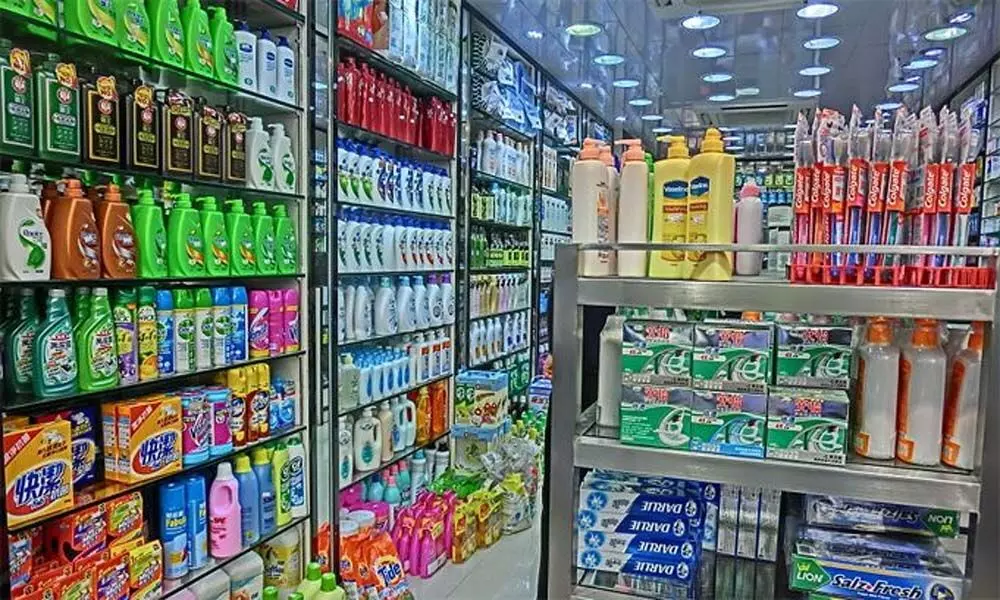FMCG mkt in India may reach Rs15.62 trn by 2025
India has an astonishing youth population when compared to other developing countries. The majority of the workforce in India comprises this young population and this group of people will be a major growth driver especially for the packaged foods category as they barely get time to cook
image for illustrative purpose

FMCG industry is India's fourth largest and a major contributor to the country's economy. Some of the FMCG products that dominate the market include toiletries, oral hygiene products, detergents, cosmetics and so on. Raw material availability, lower labour cost and a well connected value chain gives India a competitive advantage for the FMCG industry.
The three major segments of FMCG industry are: Food & Beverages; Household & Personal Care and Healthcare India is the most attractive FMCG market in the world. FMCG market matured in India over the years but still it is highly fragmented. There are around 12-15 million outlets in the country making it a $ 327 billion market, according to a Ikon Marketing Consultants report. The FMCG market in India is estimated to grow at a CAGR 15 per cent to reach Rs 15.62 trillion by 2025 from Rs 7.814 trillion in 2020.
Indian FMCG space is majorly dominated by unorganised players. However, under the organised market there are various players dominating in different segments of the Industry. HUL is a major player in the organised market manufacturing various products related to food and beverages, household and personal care witnessed a revenue of Rs 459.9 billion in 2020-21. Followed by Patanjali, an Indian company that positioned itself as a manufacturer of natural and Ayurvedic products made a revenue of Rs 300 billion in 2020-21. The revenue of Nestle India, one of the largest manufacturers of food products stood at Rs 132.9 billion in 2020-21. Some other notable players include; Britannia Industries, ITC, Godrej and P&G. India's 65 per cent of the population lives in the rural areas. Over the years, FMCG consumption in these areas have increased due to the increasing income levels and demand for branded products. According to estimates, rural households contribute around 36 per cent-37 per cent of the total FMCG sales in the country.
The rising wages and changes in lifestyle of consumers accelerated the trend towards premiumisation in the country. Consumers are well-informed about the products and willing to pay more to buy branded items that suit their lifestyle and social status.
India has an astonishing youth population when compared to other developing countries. The majority of the workforce in India comprises this young population and this group of people will be a major growth driver especially for the packaged foods category as they barely get time to cook.
E-commerce has completely revolutionized the way consumers buy goods. FMCG companies utilise e-commerce platforms as a way to test their new product innovation and new concept to reach a larger audience. Since e-commerce provides the convenience of ordering products using a mobile device or a computer consumers' preference towards online shopping is on the rise.
The FMCG Industry in India saw tremendous growth in the recent decade with the rising disposable income and economic growth. However, the coronavirus has caused a liquidity crunch for most of the consumer goods companies in India. A paradigm shift in consumer's buying behaviour can also be noticed during the pandemic which is likely to continue post-pandemic. Most people choose to buy things online in order to avoid in-store visits. With the second wave of the virus hindering economic growth of India, FMCG companies are using automation and analytics to hasten the manufacturing process and move stocks from warehouse to customers' point of purchase. Industry leaders are expecting rural India to be the future revenue driver backed up by support from the government, reverse migration and low unemployment rate. Though, FMCG industry saw signs of recovery during the third quarter of 2020, the ongoing second wave of the virus may slow down the recovery and we estimate that the industry may fully bounce back by the end of 2021.
Various industries, especially the FMCG industry has taken a drastic hit due to the ongoing Covid-19 pandemic that has caused an overall destruction across many sectors of the industry. The prevalent lockdown over the past year has caused many sectors to shut operations completely and exit the industry all together, while the remaining are still hanging on by a thin thread. Relaxations in the lockdown across the majority of states, now comes as a breath of fresh air for the FMCG industry as they are now gearing up to jump back into action and hope to gather and recoup in order to stand back on their feet and get things going for them.
The FMCG industry will be focusing on the upcoming festive season in order to boost sales and attract customers with their exciting offers. The industry experts have high expectations from this festive season and have begun strategizing their upcoming plans to bounce back and give it their best shot.

